My Lai Massacre in Quang Ngai
My Lai in Vietnam was well-known in the world because of the terrible massacre that happened in 1968.
Vietnamdrive studied and collected helpful information in this article, which can help readers learn more about what happened during the war in Vietnam.
All of us wish that the bad things of war would not occur again. When we read the history of war, we know the value of a peaceful life in the present to live better.
On the morning of March 16, 1968, in the area of My Lai Commune in Son My Village, Quang Ngai Province, Vietnam, a unit of US Army soldiers massacred 504 innocent civilians, including primarily elderly, women, and children. The bloody massacre shocked the public all over the world. This activity was a terrible problem happening during the Vietnam War.
The location of My Lai Village
Son My (My Lai) Village is located next to Highway 24B and belongs to Tu Cung Hamlet, Tinh Khe commune, Son Tinh district, about 12km from the city center of Quang Ngai to the northeast.
This place preserves evidence of the massacre in 1968, including displaying historical images and artifacts and placing a memorial statue of the 504 people for the My Lai massacre or the Son My massacre.

Son My was the name of the Saigon government (South Vietnam) for the Tinh Khe commune. My Lai was written in the documents, maps of the army, and later in the American presses, appointing Tinh Khe commune.
My Lai is a name that originated from My Lai Commune, one of four communes of Son My Village. Pinkville was another name for My Lai, which the US military used as a nickname in combat maps.
My Lai Vietnam Massacre in 1968
Below is information that our team collected from various docoments telling about this place.
My Lai was a peaceful commune with a sand road covered by the shade of coconut trees. Most of the local people were farmers. Here is the brief of the massacre in 1968.
My Lai massacre occurred on March 16, 1968 (the 18th of the second lunar month, Mau Than – Monkey Year). The central unit that caused the bloody death and shocked the world is Platoon 1 (Lieutenant William Calley was the platoon leader) of Charlie Company (The Captain is Ernest Medina). This group was one of 3 companies of Barker (Task Force Barker), Brigade 11, American Division, and American Expeditionary Forces.
On that terrible morning, after the series of shells rushed into the village, American troops landed by helicopters into the field in the west of Tu Cung and Go hamlets (Co Luy village) in Tinh Khe Commune. The fierce and destructive massacre began with American soldiers hunting and firing at regular civilians (including older people, women, and children). Houses and shelters were collapsed and burned, and castles were shot and killed. The soldiers pushed down dozens of victims’ bodies into a ditch.
Frightening truth: In just one morning, 504 innocent people were killed (407 people in Tu Cung Hamlet, 97 people in My Hoi Hamlet), including 182 women, 173 children, and 60 older adults. Twenty-four families were killed, and 247 houses were destroyed.
Seeing the terrible deaths, a soldier, Herbert Carter, shot himself in the leg to avoid participating in the massacre.
Helicopter pilot Hugh Thompson, the 24-year-old man of the squadron team, witnessed hundreds of people dyed or dying when flying through the village. He and the squadron team saw an unarmed woman in droop, kicked on her body, and shot. They were contacted by radio to seek help for the injured people. After that, the helicopter landed near a ditch which had full of corpses, and there were also some wounded people. Thompson asked soldiers there to help the survivors.
A group of Vietnamese civilians (only children, women, and older men) hid in a cellar that American infantrymen were approaching. Thompson helped about 12-16 people in the tunnel to escape from the massacre.
In 1998, three US military soldiers, including Hugh Thompson (pilot), Glenn Andreotta, and Lawrence Colburn (gunmen in the aircraft), were awarded medals by the US government for blocking civilian killers, reducing casualties in the My Lai Massacre. Thompson and Colburn later returned to the village and met the rescued people.
Telling the truth of My Lai Massacre
However, the truth of the My Lai Massacre was kept until November 1969. Seymour Hersh, the world-renowned investigative journalist, was the one who revealed to the world the terrible slaughter after many conversations with William Laws Calley – who was later accused of ordering the massacre of My Lai.
And, in November 1969, a series of magazines, including Time, Life, and Newsweek, published on the first page the detailed photos of villagers who were killed at the hands of American soldiers in My Lai.
Terrifying news about the massacre warmed up the anti-war movement in Vietnam. The American people and the world demanded the withdrawal of US troops from South Vietnam.
The case of My Lai in Vietnam also caused many young Americans to have more reasons to oppose joining the soldiers coming to Vietnam, and those who had the anti-war ideology received more strength to ask to stop the war.
Terrifying stories about the war were also gradually shown to the light.
We always hope that the terrible things of war will not happen again in everyday life and that all people will be happy to live together.
-
Allowed to take pictures
-
Bike Parking
-
Parking Section
-
History & Culture
